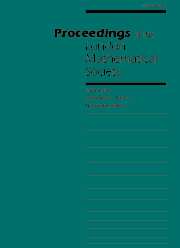Crossref Citations
This article has been cited by the following publications. This list is generated based on data provided by
Crossref.
Kim, Jongsu
and
Sung, Chanyoung
2002.
Deformations of Almost-Kähler Metrics with Constant Scalar Curvature on Compact Kähler Manifolds.
Annals of Global Analysis and Geometry,
Vol. 22,
Issue. 1,
p.
49.
Lin, Yi
and
Tolman, Susan
2006.
Symmetries in Generalized Kähler Geometry.
Communications in Mathematical Physics,
Vol. 268,
Issue. 1,
p.
199.
Hitchin, Nigel
2006.
Instantons, Poisson Structures and Generalized Kähler Geometry.
Communications in Mathematical Physics,
Vol. 265,
Issue. 1,
p.
131.
Davidov, Johann
and
Mushkarov, Oleg
2007.
Twistorial construction of generalized Kähler manifolds.
Journal of Geometry and Physics,
Vol. 57,
Issue. 3,
p.
889.
Kapustin, Anton
and
Tomasiello, Alessandro
2007.
The general (2, 2) gauged sigma model with three-form flux.
Journal of High Energy Physics,
Vol. 2007,
Issue. 11,
p.
053.
Apostolov, Vestislav
and
Gualtieri, Marco
2007.
Generalized Kähler Manifolds, Commuting Complex Structures, and Split Tangent Bundles.
Communications in Mathematical Physics,
Vol. 271,
Issue. 2,
p.
561.
Zucchini, Roberto
2007.
The Hitchin model, Poisson-quasi-Nijenhuis, geometry and symmetry reduction.
Journal of High Energy Physics,
Vol. 2007,
Issue. 10,
p.
075.
Halmagyi, Nick
and
Tomasiello, Alessandro
2009.
Generalized Kähler Potentials from Supergravity.
Communications in Mathematical Physics,
Vol. 291,
Issue. 1,
p.
1.
Jelonek, Włodzimierz
2009.
Bi-Hermitian Gray surfaces II.
Differential Geometry and its Applications,
Vol. 27,
Issue. 1,
p.
64.
Salamon, Simon
and
Viaclovsky, Jeff
2009.
Orthogonal complex structures on domains in $${\mathbb {R}^4}$$.
Mathematische Annalen,
Vol. 343,
Issue. 4,
p.
853.
Cavalcanti, Gil R.
and
Gualtieri, Marco
2011.
Blowing up generalized Kähler 4-manifolds.
Bulletin of the Brazilian Mathematical Society, New Series,
Vol. 42,
Issue. 4,
p.
537.
Deschamps, Guillaume
2011.
Compatible complex structures on twistor space.
Annales de l'Institut Fourier,
Vol. 61,
Issue. 6,
p.
2219.
Goto, Ryushi
2012.
Unobstructed K-deformations of generalized complex structures and bi-Hermitian structures.
Advances in Mathematics,
Vol. 231,
Issue. 2,
p.
1041.
CALVARUSO, GIOVANNI
and
FINO, ANNA
2013.
COMPLEX AND PARACOMPLEX STRUCTURES ON HOMOGENEOUS PSEUDO-RIEMANNIAN FOUR-MANIFOLDS.
International Journal of Mathematics,
Vol. 24,
Issue. 01,
p.
1250130.
Pontecorvo, Massimiliano
2014.
On a question of Vaisman concerning complex surfaces.
Annali di Matematica Pura ed Applicata (1923 -),
Vol. 193,
Issue. 5,
p.
1283.
Gualtieri, Marco
2014.
Generalized Kähler Geometry.
Communications in Mathematical Physics,
Vol. 331,
Issue. 1,
p.
297.
Fujiki, Akira
and
Pontecorvo, Massimiliano
2015.
Numerically anticanonical divisors on Kato surfaces.
Journal of Geometry and Physics,
Vol. 91,
Issue. ,
p.
117.
Apostolov, Vestislav
and
Dloussky, Georges
2016.
Locally Conformally Symplectic Structures on Compact Non-Kähler Complex Surfaces.
International Mathematics Research Notices,
Vol. 2016,
Issue. 9,
p.
2717.
Pontecorvo, M.
2017.
Complex and Symplectic Geometry.
Vol. 21,
Issue. ,
p.
191.
Perrone, D.
2017.
Taut contact circles and bi-contact metric structures on three-manifolds.
Annals of Global Analysis and Geometry,
Vol. 52,
Issue. 2,
p.
213.

